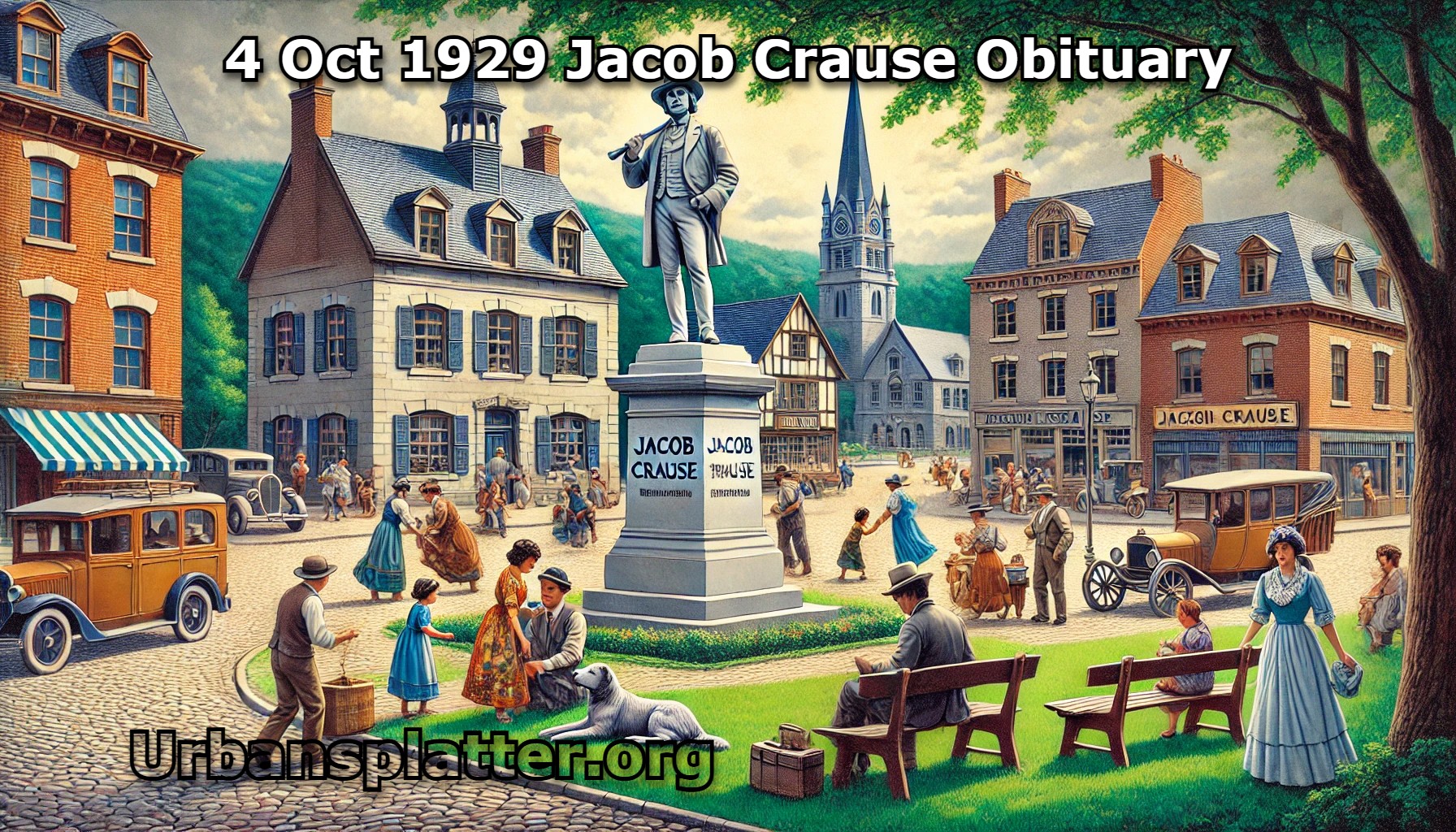Picture yourself on 4 Oct 1929 Jacob Crause Obituary, an era bustling with change, uncertainty, and the looming shadow of the Great Depression. On October 4, a name emerged in the obituaries, that of Jacob Crause. Who was he and why should we care? Let’s embark on this journey together that promises to reveal more than just a name tucked away in the pages of history.
The Historical Context of 1929
In 1929, the world stood at a crucial juncture. Significant events unfolded, changing lives and shaping history. You may wonder, what made this year so pivotal? Let’s explore the major happenings, the impact of the stock market crash, and the cultural shifts that defined America during this time.
Overview of Significant Events in 1929
1929 was a year filled with notable occurrences. Here are some key events:
- The stock market crash in late October marked the beginning of the Great Depression.
- Various influential figures, including artists, politicians, and innovators, passed away.
- Significant cultural milestones, such as the rise of jazz music and the popularity of cinema, took center stage.
These events intertwined, creating a complex tapestry of social and economic change. The crash alone sent shockwaves through the nation, altering the course of many lives.
Impact of the Stock Market Crash
The stock market crash of October 1929 is often cited as the catalyst for the Great Depression. But what does this mean for the average American? In simple terms, it meant financial ruin for many. People lost their savings, jobs were cut, and businesses failed. This crash wasn’t just numbers on a screen; it was a personal tragedy for families across the country.
Imagine waking up one day to find your life savings vanished. This was the reality for countless Americans. The psychological toll was immense. People began to lose faith in the system that had promised prosperity.
Social and Political Landscape of America
During this tumultuous time, America underwent significant social and political changes. The government struggled to respond effectively to the crisis. You might ask, how did the people react? Many turned to grassroots movements, seeking solutions and support.
- Labor unions gained strength as workers demanded fair wages and conditions.
- Political figures emerged, promising reform and change.
- The role of women began to shift, with more women entering the workforce.
These changes reflected a society grappling with uncertainty. The old ways were crumbling, and new ideas began to take root.
Cultural Shifts During This Period
As the economic landscape changed, so too did the cultural fabric of America. The 1920s had been a time of excess and celebration, but the crash brought a sobering reality. People turned to art, music, and literature for solace. Jazz music, which had gained popularity in the previous decade, became an anthem of resilience.
Think about it: in times of hardship, people often seek comfort in creativity. This period saw the rise of iconic figures like Louis Armstrong and Duke Ellington. Their music resonated with the struggles of everyday life.
How Obituaries Reflected Societal Values
Interestingly, obituaries from 1929 provide a unique lens through which to view societal norms and values. They often highlighted the accomplishments of individuals, reflecting what society deemed important. You might wonder, what can we learn from these obituaries?
They serve as a historical record, showcasing the aspirations and achievements of people from all walks of life. As the saying goes,
“Obituaries are the books of our lives. They help us understand who we are and who we were.”
This sentiment rings true, especially during a time of upheaval.
Introduction to Historical Figures of the Time
Throughout 1929, several historical figures left a lasting impact. Their contributions shaped the nation’s response to the challenges it faced. Here are a few notable individuals:
- Jacob Crause: A prominent figure whose obituary reflects the values of resilience and determination.
- Louis Armstrong: A jazz musician whose work inspired hope and joy amidst despair.
- John Steinbeck: An author who captured the struggles of the common man in his writings.
These individuals, among others, played pivotal roles in navigating the complexities of their time. Their legacies remind us of the strength of the human spirit.
Understanding the backdrop against which 4 Oct 1929 Jacob Crause Obituary life unfolded is crucial to appreciating his legacy. The events of 1929 were not merely historical footnotes; they were transformative moments that shaped the lives of many. As we delve deeper into this period, you’ll uncover the intricate connections between these events and the lives they touched.
Who Was Jacob Crause?

Early Life and Upbringing
Jacob Crause was born in 1885. His early life was marked by humble beginnings. Growing up in a small community, he learned the value of hard work and perseverance. Imagine a young boy, watching his parents toil to make ends meet. This environment shaped his ambitions and values profoundly.
His family instilled in him the importance of community and service. They believed that helping others was a duty, not an option. This principle became a cornerstone of Crause’s life. How many of us can say that our childhood experiences have such a lasting impact?
Contributions to His Community
Jacob Crause engaged in several notable civic endeavors throughout his life. He was not just a participant but a leader. His most significant contributions were in community organizing and public service. He understood that real change comes from within the community.
- He organized local events to foster unity.
- He advocated for better public services and facilities.
- His efforts helped improve the quality of life for many.
These actions were not merely about making things better for himself. They were about uplifting everyone around him. As he once said,
“A life well-lived is marked not by wealth, but by the richness of impact on others.”
Career Milestones and Achievements
Crause’s career was filled with milestones that showcased his dedication to public service. He held various positions that allowed him to influence policy and community development. His work often intersected with local government, where he pushed for reforms that benefited the public.
One of his significant achievements was the establishment of community programs aimed at youth development. These programs provided education and resources to children who otherwise would have had limited opportunities. Can you imagine the ripple effect of such initiatives?
Personal Anecdotes That Highlight His Character
Personal stories about Jacob Crause reveal much about his character. For instance, there was a time when he noticed a family struggling to pay their bills. Instead of turning a blind eye, he stepped in to help. He organized a fundraiser within the community, bringing people together for a common cause. This wasn’t just about raising money; it was about fostering a spirit of togetherness.
Many remember him as a person who always had time to listen. He made people feel valued. His kindness and empathy were not just traits; they were part of his identity. How often do we meet someone who truly embodies these qualities?
Connections to Notable Contemporaries
Throughout his life, Jacob Crause formed connections with notable contemporaries. His network included influential figures in politics and social reform. These relationships helped him amplify his impact. It’s fascinating how collaboration can lead to greater change.
He often worked alongside local leaders to push for initiatives that aligned with his vision for community upliftment. This teamwork was essential in driving the changes he sought. Each connection added another layer to his influence.
The Influence of His Work on Future Generations
Jacob Crause’s legacy is evident in the community programs that continue to thrive today. His work laid the groundwork for future leaders to follow. His vision of a united community inspired many to take action. It’s a testament to how one person can spark a movement.
Future generations look back at his contributions with admiration. They realize that real change often starts with a single individual willing to step up. His life serves as a reminder that community involvement is crucial. We all have the power to make a difference.
In summary, Jacob Crause’s journey provides insight into a life dedicated not only to personal gain but community upliftment. His early life shaped his values, and his contributions left an indelible mark on his community. By understanding his story, you can see how one person’s efforts can resonate through time, influencing countless lives.
The Art of Crafting Obituaries

Obituaries are more than just announcements of death. They are a tapestry woven with the threads of a person’s life. They capture the essence of who someone was and how they impacted the world around them. Understanding the art of crafting obituaries can help you appreciate their historical significance and the personal legacies they create.
1. Historical Significance of Obituaries
Did you know that obituaries have existed for centuries? They serve as vital records of human history. From ancient civilizations to modern times, obituaries document the lives of individuals and the eras they lived in. They provide insight into societal values, cultural practices, and even the evolution of language.
- Obituaries often reflect the social status and achievements of the deceased.
- They have been used to commemorate public figures, shedding light on their contributions to society.
As time has passed, the style and content of obituaries have evolved. What was once a simple announcement has transformed into a narrative that tells a story. This evolution is crucial in understanding how we remember those who have passed.
2. Personal Legacies in Obituaries
Obituaries serve as personal legacies. They are a way for families to honor their loved ones. Through carefully chosen words, they can encapsulate a person’s life achievements, passions, and relationships. Have you ever read an obituary that made you feel like you knew the person? That’s the power of a well-crafted tribute.
Consider this: every life is a story waiting to be told. Obituaries allow us to share those stories with the world. They are not just about the dates and events; they are about the emotions and experiences that defined a person.
3. Contemporary vs. Past Obituaries
There’s a striking difference between contemporary and past obituaries. In the past, obituaries were often brief and formal. They listed basic information: name, dates, and perhaps a few accomplishments. Today, they can be rich narratives filled with anecdotes, humor, and personal reflections.
- Modern obituaries often include photos, quotes, and even social media links.
- They can be shared online, reaching a wider audience than ever before.
This shift reflects changes in how we view death and remembrance. In today’s digital age, obituaries can celebrate life in a more personal and engaging way.
4. Elements of a Memorable Obituary
What makes an obituary memorable? Here are a few key elements:
- Personal Touch: Including stories or anecdotes that highlight the deceased’s personality.
- Emotional Resonance: Writing in a way that evokes feelings, making readers connect with the life lived.
- Legacy Highlights: Mentioning significant achievements or contributions to the community.
- Quotes: Using meaningful quotes can add depth and perspective.
These elements combine to create a narrative that resonates with readers. It’s not just about saying goodbye; it’s about celebrating a life well lived.
5. Cultural Perceptions of Obituaries
Cultural perceptions of obituaries vary widely. In some cultures, obituaries are elaborate and public, while in others, they may be more private affairs. Understanding these differences can provide insight into how various societies cope with loss.
- In some cultures, obituaries serve as a call to community members to come together in remembrance.
- Others may view them as a way to reflect on the impact of the deceased on their community.
These perceptions shape how we write and read obituaries, influencing the language used and the stories told.
6. Obituaries as Reflections of Historical Narratives
Obituaries are not just personal tales; they are reflections of historical narratives. They can provide context to the times in which someone lived. For instance, an obituary from the early 20th century may highlight struggles during a war or significant social changes.
When you read an obituary, you are often getting a glimpse into the past. It’s a snapshot of a moment in time, illustrating how individual lives intersect with larger historical events.
“Every funeral is a celebration of life, but obituaries are the lasting tributes.” – Unknown
This quote encapsulates the essence of what obituaries represent. They are lasting tributes that preserve memories and stories for future generations.
In summary, understanding the nuances behind obituary writing can enrich your reading experience. It allows you to appreciate figures like Jacob Crause, whose life story is intertwined with the fabric of history. As you delve into the art of crafting obituaries, consider how these narratives shape our understanding of life and death.
Jacob Crause’s Legacy and Impact

When you think about the lasting impact of influential figures, Jacob Crause stands out. His contributions continue to resonate, shaping not only his contemporaries but also future generations. Let’s explore the long-term effects of his work and why it matters today.
1. Long-term Effects of His Work
Jacob Crause was not just a name; he was a catalyst for change. His work laid the groundwork for many initiatives that we see today. Many institutions still benefit from the changes he initiated. For example, educational frameworks and community programs owe a debt to his innovative ideas.
- His influence can be seen in modern educational practices.
- Many community organizations still implement his strategies.
- His advocacy for social justice has inspired numerous movements.
Isn’t it fascinating how one person’s actions can ripple through time? Crause’s legacy is a testament to that idea.
2. Remembering Influential Figures and Their Stories
Why do we remember figures like Crause? Their stories are powerful reminders of what can be achieved. Each story is a thread in the tapestry of history. They inspire us to aspire to greatness.
When we share these stories, we keep their spirit alive. It’s like passing down a family recipe; the essence remains, even as the ingredients change. Crause’s narrative is a beacon for those who seek to make a difference.
3. How Krause’s Work Shapes Contemporary Narratives
Today, we see echoes of Crause’s work in various fields. From education to community service, his principles guide us. They shape contemporary narratives about what it means to contribute to society.
For instance, the emphasis on community-driven projects in today’s educational systems can be traced back to his vision. This approach encourages students to engage with their communities. It’s a cycle of giving back that Crause championed.
4. Lessons Learned from His Life
What can we learn from Crause? His life teaches us about resilience and commitment. He faced challenges head-on and never wavered in his beliefs. This determination is something we can all strive for.
Here are a few key lessons:
- Perseverance: Never give up, even when times are tough.
- Empathy: Understand the needs of others and act accordingly.
- Community Engagement: Work together for the greater good.
These lessons are timeless. They remind us that our actions can create lasting change.
5. The Importance of Preserving Such Legacies
Why is it important to preserve legacies like Crause’s? Legacies serve as a roadmap for future generations. They remind us of our shared history and the values we hold dear.
Preserving his legacy means keeping his story alive. It helps us reflect on our own lives and the impact we want to have. It’s about ensuring that the values of community and personal contribution remain at the forefront.
6. Why We Continue to Write and Read Obituaries
Obituaries are more than just announcements of death. They are celebrations of life. They tell us about the impact a person had during their time on Earth. When we read about someone like Crause, we learn about their contributions and the lives they touched.
Consider this: how often do you reflect on the lives of those who have passed? Each obituary is a story waiting to be told. It invites us to think about our legacies.
“The greatest legacy we can leave is the impact we made in the lives of others.” – Unknown
This quote encapsulates the essence of what Crause represented. His life was a testament to the idea that our actions matter. Every small act of kindness contributes to a larger narrative.
7. Exploring Krause’s Ongoing Influence
Even decades after his passing, numerous commemorative events are held in his honor. These gatherings are not just tributes; they are opportunities to reflect on his impact. They remind us of the importance of community and connection.
When we gather to remember Crause, we celebrate the values he stood for. We explore how his teachings can guide us today. His legacy is not just a memory; it’s a living, breathing part of our culture.
In conclusion, Jacob Crause’s legacy is a rich tapestry woven into the fabric of our society. It informs future generations about the values of community and personal contribution. His life continues to inspire and influence others today.
Conclusion

As we come to the end of our exploration into the life of Jacob Crause, it’s essential to take a moment to reflect on his journey and the indelible mark he left on the world. Crause’s achievements were not just a product of his time; they were a testament to his character, his resilience, and his unwavering commitment to his values. He navigated the complexities of his era with a deftness that many admired. His story serves as a beacon, illuminating the path for those who follow.
Summarizing Krause’s Life and Achievements
Jacob Crause was more than a historical figure; he was a man who shaped his community and influenced the lives of many. His contributions span various domains, from his work in public service to his dedication to the arts. Each achievement was a stepping stone that led to greater opportunities for those around him. You might ask yourself, what can we learn from his life? The answer lies in the lessons of perseverance and dedication he exemplified.
Learning from History
History is not just a collection of dates and events; it’s a narrative filled with lessons that resonate even today. By studying figures like Crause, we can glean insights into our own lives. Have you ever considered how the past shapes the present? Understanding the trials and triumphs of those who came before us can provide clarity and direction as we navigate our paths. It encourages you to reflect on your journey and the legacy you wish to leave.
The Value of Knowing Our Predecessors
Knowing our predecessors is crucial. It allows us to appreciate the struggles they endured and the victories they achieved. This knowledge fosters a sense of connection. When you learn about someone like Crause, you realize that you are part of a larger tapestry of human existence. Each thread represents a life lived, a story told. This connection can inspire you to embrace your own story with pride.
Promoting Discussions About Personal Legacies
As we reflect on historical figures, let’s also consider our own legacies. What do you want to be remembered for? Engaging in discussions about personal legacies is vital. It encourages introspection and can lead to meaningful conversations with family and friends. You might discover shared values or aspirations that can strengthen your bonds. Think of it as a way to pass down wisdom and inspire future generations.
Encouragement to Consider Genealogical Pursuits
Have you ever thought about tracing your family history? Genealogy can be a fascinating journey. Understanding where you come from can provide context to your life. It can reveal stories of bravery, hardship, and resilience. As you delve into your roots, you may uncover connections to figures like Crause, who also navigated their unique paths. Genealogy isn’t just about names and dates; it’s about understanding the legacy left for you to build upon.
Recognizing the Continuous Impact of Past Figures
The impact of figures like Jacob Crause extends far beyond their lifetimes. They shape the values and norms of society. Have you ever felt the influence of someone you’ve never met? Whether it’s through their writings, their actions, or their ideals, the echoes of their lives resonate in ours. Recognizing this continuous impact can inspire you to act with intention, knowing that your actions today may influence others tomorrow.
In summary, reflecting on the lives of historical figures like Jacob Crause allows us to appreciate the tapestry of human existence. Each thread, each story, contributes to a greater understanding of who we are. As you ponder Crause’s life and your own, consider how history informs your present and shapes your future. The lessons learned from the past can guide you in making decisions that not only honor your legacy but also inspire those who come after you.
So, who will you remember in your own life? As you reflect on your journey, think about the individuals who have influenced you. Their legacies, like Crause’s, can inspire you to create a meaningful impact in your community and beyond. Embrace the stories of the past, engage in discussions about your legacy, and consider the profound connections that bind us all together in this shared human experience.
Frequently Asked Questions (FAQ)
In this section, we will tackle some common questions that many people have regarding Jacob Crause and the significance of obituaries in historical contexts. Understanding these topics can provide you with a deeper insight into how history shapes our present and future.
1. What notable events defined Jacob Crause’s era?
Jacob Crause lived during a time of significant change. The early 20th century was marked by major events such as:
- The Great Depression: This economic downturn affected millions and reshaped public policy.
- World War I: The aftermath of the war influenced international relations and domestic policies.
- The Civil Rights Movement: Although it gained momentum later, the seeds of change were planted during this era.
- Technological Advancements: Innovations in communication and transportation transformed daily life.
Each of these events played a role in shaping Crause’s views on public service and governance. It’s fascinating to see how history intertwines with individual lives, isn’t it?
2. Why are obituaries important in a historical context?
Obituaries serve as more than just a farewell. They are a window into the past. Here are a few reasons why they are crucial:
- Documenting Lives: They provide a record of an individual’s life, achievements, and contributions to society.
- Understanding Society: Obituaries reflect the values and norms of the time in which the individual lived.
- Historical Research: They are valuable resources for historians and genealogists seeking to understand family lineages or societal changes.
Think about it: when you read an obituary, you’re not just learning about one person; you’re learning about the world they lived in.
3. How can one research historical obituaries?
Researching historical obituaries can be an enlightening journey. Here’s how you can start:
- Visit Libraries: Many libraries have archives of local newspapers.
- Online Databases: Websites like Ancestry.com or Newspapers.com offer extensive collections of obituaries.
- Genealogy Websites: These often have dedicated sections for obituaries and death records.
- Contact Local Historical Societies: They may have records that are not available online.
With a little digging, you can uncover fascinating stories that paint a richer picture of history.
4. What are the challenges in writing obituaries today?
Writing obituaries is not as straightforward as it seems. Here are some challenges faced by writers:
- Balancing Emotion and Fact: It can be tough to convey the personal loss while maintaining factual accuracy.
- Finding the Right Tone: Striking the balance between respectful and celebratory can be tricky.
- Space Constraints: Many publications have limited word counts, making it challenging to include all relevant details.
In a world where brevity is often valued, how do you capture a life fully in just a few paragraphs?
5. How has Jacob Crause influenced modern views on public service?
Jacob Crause’s legacy is still felt today. His commitment to public service set a precedent. Here are a few ways he has influenced modern views:
- Advocacy for the Underserved: Crause emphasized the importance of serving marginalized communities.
- Ethical Governance: His principles of transparency and accountability continue to resonate.
- Community Engagement: He believed in the power of involving citizens in decision-making processes.
His life reminds us that public service is not just a job; it’s a calling. Doesn’t that inspire you to think about how you can contribute to your community?
6. Where can I find more information about historical figures?
There are many resources available to learn about historical figures. Here are some suggestions:
- Online Archives: Websites like the Library of Congress or National Archives have extensive collections.
- Biographies: Look for books or documentaries that focus on specific individuals.
- Academic Journals: These often contain in-depth research on historical figures.
- Social Media and Blogs: Many historians share insights and lesser-known facts about historical figures online.
By exploring these resources, you can uncover the rich tapestry of history and the individuals who shaped it. Isn’t it amazing how much there is to learn?
These FAQs aim to provide key insights and clarify common queries surrounding the topic. By leveraging both historical and contemporary angles of understanding, you can deepen your appreciation for the past and its influence on the present.















